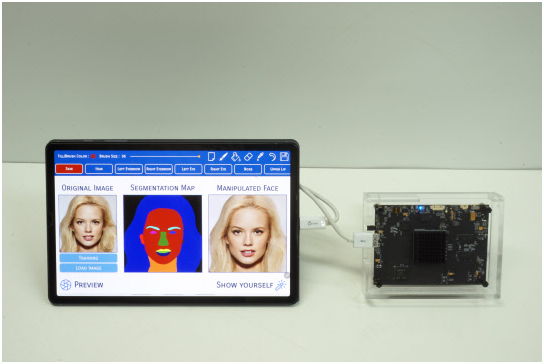KAIST Develops Technology for AI-based High-resolution Image Creation

KAIST professor Yoo Hoi-jun and his research team have developed an AI chip capable of changing and restoring the hairstyle of a person in a picture on a mobile device.
The Korea Advanced Institute of Science and Technology (KAIST) announced on April 6 that professor Yoo Hoi-jun and his research team have succeeded in developing a generative adversarial networks processing unit (GANPU) as an AI chip processing GAN with low power and high efficiency. The AI chip is capable of quickly processing arithmetic operations required for image synthesis and restoration on a mobile basis. The single chip is capable of realizing image recognition, inference, learning and determination with low power and high efficiency and is expected to contribute to the use of AI in mobile devices for more purposes.
GAN can be defined as AI technology in which a deep learning network generating fake data and a deep learning network distinguishing the fake data learn while competing with each other. The technology, which results in hardly distinguishable fake data, is applied to deepfakes, which are becoming increasingly problematic these days.
Existing AI technology has been used for object recognition, inference, voice recognition, facial recognition, etc. On the other hand, GAN, which are capable of generating and regenerating images, can be widely used for image conversion, synthesis and restoration and in various mobile applications. Various industries and academic fields are paying much attention to the versatility of the technology nowadays.
Still, this new type of network is made up of multiple deep neural networks unlike existing deep learning networks and, as such, it is not easy to increase the operation speed and a lot of operations are required in the case of high-resolution images. This means the network cannot be realized by software alone on mobile devices such as smartphones, which are limited in operation capacity and usable memory capacity.
The AI chip developed by the research team is characterized by being capable of learning on a mobile basis while processing multi-column deep neural networks such as GAN as well as single deep neural networks. The chip is capable of learning GAN on its own in a mobile device without data transmission to a server.
The team succeeded in setting up a face correction system by means of the chip. In that system, 17 features related to hair, glasses, eyebrows and so on can be automatically added to or deleted from a picture taken with a tablet PC camera. Details of the research were presented at last month’s International Solid-State Circuits Conference (ISSCC) in San Francisco.